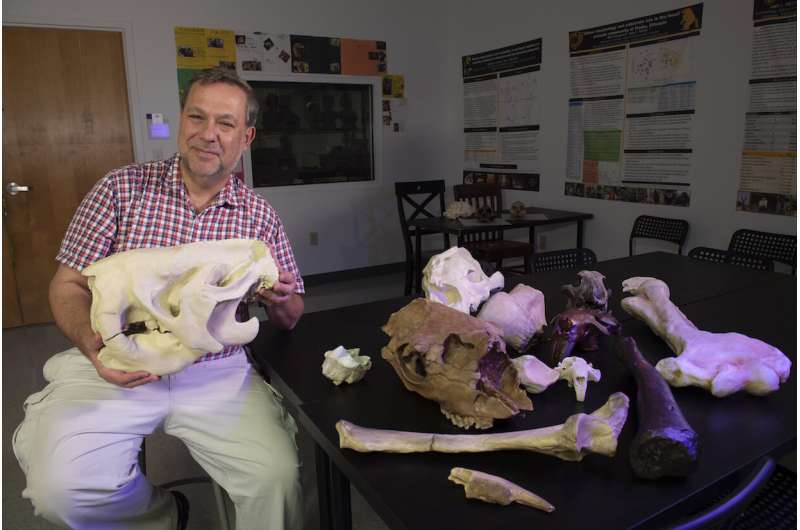U.S. founding fathers were obsessed with American Ice Age megafauna

Around the time of the Revolutionary War, the Americans faced a threat beyond the British: the ideas of French naturalist Georges-Louis Leclerc, Comte de Buffon, the world's leading intellectual at the time and author of the authoritative "Histoire naturelle."
"One of the ideas the Comte de Buffon had was related to American degeneracy. He believed that if you lived in the Americas already, you're weaker and smaller than anything in the Old World," said Bernard Means, Ph.D., assistant professor of anthropology in the School of World Studies in the College of Humanities and Sciences. "And, he believed, if you came to the Americas, you would also begin to become weaker and smaller and more effeminate."
Disproving this belief was seen as critical by Thomas Jefferson, Benjamin Franklin, George Washington, Alexander Hamilton and other early American leaders. And a key piece of their counterargument were the fossils of giant Ice Age mammals—mastodons, giant ground sloths and giant beavers—that were being discovered in the 18th and early 19th centuries in New York, Virginia, Kentucky and elsewhere in the New World.
The founding fathers' fascination with Ice Age megafauna was the subject of Means' lecture, "America's Founding Monsters," delivered as part of a Halloween open house Thursday at the Virtual Curation Laboratory. At the lab, Means and his students use 3-D scanning and printing technology to create models of historical, archaeological and paleontological objects used for teaching, research and public outreach.
"Jefferson, Franklin, Washington, Hamilton, Madison, they were all concerned with this notion of American degeneracy. They wanted people to come to the Americas and they were also afraid that people wouldn't buy American goods," Means said. "They saw these fossils as proof that we had big things."
On display at the open house were an array of realistic looking 3-D-printed replicas, including a mastodon tooth once owned by Franklin, several giant ground sloth bones owned by Jefferson, and a giant ground sloth skull from Darke County, Ohio, (the species was named Megalonyx jeffersonii after Jefferson). Means and his students created the 3-D replicas after scanning the original artifacts at institutions such as Franklin Court and The Academy of Natural Sciences of Drexel University in Philadelphia.
"People were finding all these massive bones at the time," Means said. "Initially, people thought they were giants. Some of the first to recognize mammoth bones were actually extinct elephants—and not giant people—were enslaved Africans. They'd seen elephants before."
One of the 3-D-printed replicas on display was a mastodon leg bone owned by Jefferson that had been collected by William Clark in 1807 as part of a special mission to Big Bone Lick in Kentucky to bring back fossil specimens. Jefferson, Means said, believed that mastodons were still roaming the unexplored Western United States.
Jefferson was so enamored with fossils that he devoted a room in the White House to their display. He was attacked for his interest by political opponents and in a poem by William Cullen Bryant: "Go, wretch, resign the presidential chair, Disclose thy secret measures, foul or fair. Go, search with curious eye for horned frogs, "Mid the wild wastes of Louisianian bogs, Or, where Ohio rolls his turbid stream, Dig for huge bones, thy glory and thy theme."
Washington, Means said, took a break during the Revolutionary War to visit a farmer's house because he'd heard they had discovered mastodon bones.
The mastodon tooth belonging to Franklin was discovered at Franklin Court—the site of Franklin's home while he served in the Continental Congress and the Constitutional Convention and now run by the National Park Service—during renovations in the 1950s. "An electrician found it," Means said. "We know for sure that Franklin was sending mastodon bones to Europe."
In addition to the 3-D-printed megafauna bones and the Halloween themed skulls and other creepy artifacts on display Thursday, Means also had a few other Ice Age samples of interest.
"I have some 3-D-printed giant ground sloth poop over there that I scanned for a museum in California," he said. "They want to do an exhibit on poop. They knew that the Smithsonian had drawers full of giant ground sloth poop, so they contacted me to go up there to scan some of it."
Means' research into 3-D scanning and the interest of early American leaders in Ice Age megafauna has been awarded a grant from the Humanities Research Center in the College of Humanities and Sciences. It will allow him to travel to the American Philosophical Society and The Academy of Natural Sciences for additional research and to scan more fossils belonging to Jefferson.
Means said his ultimate goal is to write a children's book on the topic.
"What's interesting to me is how intertwined much of this [interest in fossils] is with this country's early history," Means said. "You've adopted a new country. You want to know everything about it. Jefferson was considered an enlightened philosopher. Benjamin Franklin was one of the few people that Europeans acknowledged as a genius. And so all of these people are interested in the world around them and in making observations, and a lot of that interest was really driven by a desire to prove that the Americas were as good or better than Europe."
Provided by Virginia Commonwealth University




















